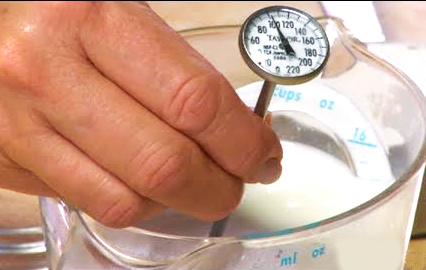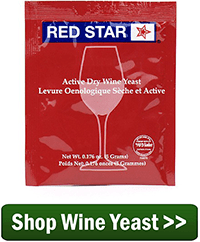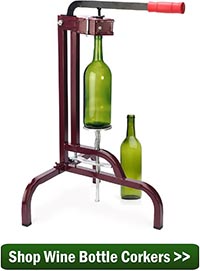 Maybe you can answer a question that I have. When adding wine yeast to a juice or kit, do you need to place it in hot water as the directions say on the yeast package, or can you just sprinkle it onto the must? I noticed that some wine recipes call for the wine yeast to be placed in hot water first, and other recipes call for the yeast to be sprinkled on the top of the must. What is the best thing to do?
Maybe you can answer a question that I have. When adding wine yeast to a juice or kit, do you need to place it in hot water as the directions say on the yeast package, or can you just sprinkle it onto the must? I noticed that some wine recipes call for the wine yeast to be placed in hot water first, and other recipes call for the yeast to be sprinkled on the top of the must. What is the best thing to do?
Eric L. – OH
—–
Hello Eric,
You are correct! There is some conflicting information running round when it comes to adding yeast to homemade wine. Almost all wine ingredient kit directions and wine recipes will say to sprinkle the dried wine yeast directly on top of the juice, but if you look at the packet of wine yeast itself, it will have directions that instruct you to put the yeast in warm water first. So, what should you do? How should you pitch the wine yeast?
Putting the wine yeast in warm water before adding it to a juice is a process called rehydration. What rehydration does is take a dried wine yeast and bring it back to an active state.
If you pitch the dried yeast directly into the wine must it will rehydrate and eventually start fermenting, anyway. So why do the yeast producers recommend this extra step before adding the yeast to the wine juice?
Why Rehydrate The Wine Yeast?
When a yeast cell rehydrates, its cell wall is swelling and gaining back its elasticity – its ability to flex and and be soft. This is a process that is prone to leaving a few cells damaged. In fact, a percentage of them don’t make it. But, by using plain water at an optimal temperature you are reducing the number of yeast cells that are being damaged during the rehydration process.
Why Sprinkle The Wine Yeast?
The reason wine ingredient kit producers, wine recipes, and even the directions on our website do not mention rehydrating before pitching the wine yeast is that many home winemakers – particularly beginners – do not perform the rehydration process correctly. Some tend to gloss over this procedure, not knowing its importance. This can cause more problems than if they had just added the dried yeast directly into the must.
As an example, the typical rehydration directions for adding yeast to a homemade wine goes something like this:
“Dissolve the dried yeast in 2 ozs. of warm water (100° – 105° F.). Let stand for 15 min. without stirring. After 15 min. stir and add to must.”
These are great directions and should be the directions you use with the yeast that came in this packet, that is, if you follow the directions, exactly. But if you don’t follow the directions, exactly, then things can start to go wrong – very wrong!
It is important to understand that at 100° – 105° F. a small portion of the yeast cells are dying every minute, and as the temperature goes up an even larger number die every minute. What this means is that if a thermometer is not used to make sure that the water is at or below 105° F., or the yeast cells are allowed to stay in the water for longer than 15 minutes, too much, or potentially all of the yeast can be destroyed before making it to the juice or wine kit.
A second complication is that it can take overnight or even a couple of days, for some, to discover that their wine is not fermenting or fermenting very sluggishly – much more so than if they’d just sprinkled the yeast onto the wine must in the first place. And this is a time that the wine is most susceptible to contamination and spoilage – before any alcohol has been made to help protect it. It needs an active fermentation to start up in a timely manner.
 For this reason, wine kit producers elect to play it safe and advise that adding the yeast to your wine, that you sprinkle the dried yeast on top of the wine must. This is a much better option that having a first-time winemaker ruin their wine.
For this reason, wine kit producers elect to play it safe and advise that adding the yeast to your wine, that you sprinkle the dried yeast on top of the wine must. This is a much better option that having a first-time winemaker ruin their wine.
What Should You Do?
Regardless of what method you use for adding yeast to your homemade wine – sprinkle dried yeast on the must or rehydrate the yeast – some of the yeast cells will die before going into action. That’s just the way it is, but that’s okay. The number of yeast cells that are provided in each packet allow for this attrition. Just remember that if you do decide to rehydrate your wine yeast before pitching it, it is critical that you follow the directions closely with regards to temperature and time. If you’re not willing to go through the hassle, just sprinkle the yeast on the must.
Happy Wine Making

I might also add that using water with chlorine (tap water) may add to the number of dying yeast cells. Purified water or RO water is better.
Regarding the addition of the yeast:
I have used the following procedure for years and it has never failed:
Add the yeast to 100 to 105 degree (no more, no less) bottled drinking water. Use about 2 cups of water. Do not stir. Wait 15 minutes. Pour 1 cup of the must into the water/yeast mix. Allow to sit for another 15 minutes. Give a gentle stir. Pour the rehydrated yeast on top of the must. Don’t stir.
If the temperature of your yeast is around 70 degrees you will see active fermentation within 24 hours. This works!
Logan
I use a multi-step process. I add the yeast packet to about 400cc of 85 to 90 degree water. I use a magnetic stirrer and start stirring immediately. In about a half an hour I add about 500cc of my must and use the magnetic stirrer for another half hour or so. I do monitor the temperature and I use a 100w electric light bulb placed near the stirring solution to keep the must at about 100 degrees. I add the solution back into my primary and I usually have an active fermentation within 3 to 6 hours. I have never had a fermentation fail to start and work completely. The magnetic stirrer is a great and useful addition to the winemakers toolkit. I have a six position one, so I can start six different wines at the same time. It is also handy for mixing small batches of sterilizing solution, campden solution, etc. Magnetic stirrers are easily found used on eBay and the number of stations (from 1 to 6) generally determines the price.
I use 8 to 10 ozs of my wine and mic to a warm finger touch in a cup or jar and then add my wine yeast and cover with a clean cloth and within 15 minutes you can see the fermentation beginning. I have used this procedure for over the last 20 years and so far have not lost any wine due to lack of fermentation.
What if you didnt follow the steps exactly? Can I sprinkle more yeast on top if fermentation never starts?
Liz, yes you can absolutely sprinkle another packet of yeast on top. If you still do not have any fermentation activity, there may be something else going on. I would take a look at the article posted below on the most common causes of fermentation failure.
Top Ten Reasons For Fermentation Failure
http://www.eckraus.com/wine-making-failure
Also, on the packet of yeast it says to keep refrigerated, but it comes inside the wine kit. Is this bad for the wine or okay?
Author, the yeast is fine when not refrigerated as long as it is used within one year. Keeping it in the refrigerator will keep it good for about 2 years.
Should the juice be the same temperature as the 15 minute hydrated yeast or colder?
Penny, wine yeast likes to ferment between 70-75 degrees, that is the temperature your juice should be.
Just would like to add a few things from my own experience.
1) if you keep your yeast refrigerated, please take it out and allow your pack
to be at room temperature before re-hydration
2) it is recommended to use 105F warm water for re-hydration. You have risk to
lose 50% of your cells if your must has different temperature. The difference in temperature
will shock and kill your yeast.
How to avoid this and make re-hydration effective:
Your body has temperature 36.6C. Trust your body. Put your finger into water you use for
Re-hydration. If you fill warm, it means your water is higher in temp than 36.6C
To prevent yeast from shock your finger must fill no difference in temperature of must
To re-hydrate your yeast without losing part of it, give em some food right away.
Add some must into your re-hydration while waiting for 15 min recommended.
After you see foam on top about half inch, pour your yeast into must,
Do it very gently to make sure your re-hydrated yeast all on surface. Do not steer for at least one
hour after that steer gently. Just remember your yeast are live creatures, it is very easy
To kill those creatures if you do not know how to feed them
Hello Ed & team!
I follow you for long time, maybe more than 2-3 years and always you give something that I missed before. Thank you, Ed. I can prove that your website is equal to university course and after a few years any novice winemakers who took your classes will be a diplomant of master degree in wine making. Seriously! I have tried free search online, I was following to my friends from France and California in their methods…. But there is always something missing… I know for sure, your education is BEST. Thank you again for everything, I became a best winemaker in my area and have nickname between all thousands of my neighborhood as “wineman”.
One thing in process is not clear for me and I need your advice:
Loading bucket with fruits and sugar I add potassium METABISULFITE and pectic enzyme, same time. After 24 hrs the yeas will be added. I have no problem with high temperature up to 90F. I have no problem with start fermentation right away, within first hour and going strong to grow the yeast colony to its maximum within 4-5 days. I learned how to make dry wine in tropical climate, where all my colleagues have stuck fermentation and sweet wine in result. I have problem with mango and banana to make wine clear after fermentation is done. Pectin hase is forcing me to keep this wine for clearing/aging time a few months, somethimes even a year. And I add Pectic Enzyme double dose for those fruits, but still….
Maybe form the very beginning I should add potassium METABISULFITE first and not to add Pectic Enzyme until next day, just before adding yeast?
What would be your advise? Thank you!!
Sorry to bother, once the yeast has been directly added to the must, how long before I can see the process starting? It has been roughly 24 hrs and nothing seems to be happening. First time trying this.
Kevin, it can take 24-48 hours for the yeast to start fermenting. If you do not see any activity, there may be something causing this to happen. The article below will cover the most common reasons for a stuck fermentation.
Top Reasons For Fermentation Failure
https://eckraus.com/wine-making-failure/